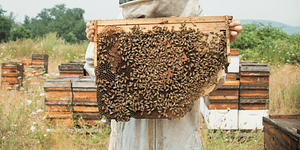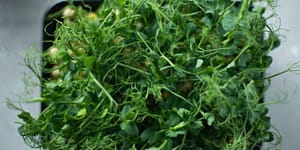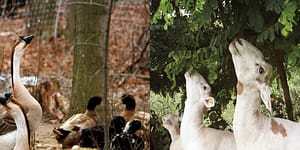Composting as if it Mattered

Composting is more than a way to minimize waste and supplement your garden. It is a method which can be practiced and perfected to “supply all the needs of [your] crops and the soil in which they live.” Composting master Will Bonsall has honed the craft to be so efficient that he has made over 200 tons of compost in his lifetime.
“I still think its more fun than a barrel of monkeys to take a mess of useless stuff and turn it into a valuable product.”
You should consider following in his footsteps.
The following excerpt, from Will Bonsall’s Essential Guide to Radical, Self-Reliant Gardening by Will Bonsall. It has been adapted for the web.
I’ve known very few gardeners whose compost making furnishes most of their crops’ nutrient needs.
How far can grapefruit rinds and coffee grounds go toward building up the soil? Typically, gardeners say that their compost is a source of humus, a source of trace minerals, or a bioactivator. They rely on hauled-in animal manure or purchased lime and other mined minerals to do the heavy lifting. This is where my garden-without-borders is different: My compost, in conjunction with green manure rotations and mulch, is intended to supply all the needs of my crops and the soil in which they live—the humus, the NPK, the good cooties, and so forth. And the ingredients in my compost all come from my immediate neighbourhood. I do not bring in significant amounts of other stuff from afar. The main exception is leaves from the nearby town of Farmington, which I could as well collect from my own forest (and do), but theirs go to the landfill anyway, and I like to prevent that when I can.
Of course, many gardeners go beyond that and add their yard waste—leaves and grass clippings—which is a huge improvement. (You can see how nicely these things fit in with that eco-efficiency business I was talking about earlier.) Even so, typical compost systems are often wasteful and counterproductive. The ingredients consist largely of weeds, crop residues, and kitchen wastes whose nutrients arise from the garden or the marketplace. They get piled in a nondescript heap in a corner of the yard. There are no precise boundaries around the heap, so the stuff at the edges kind of moulders into the ground (a net loss to the garden system). Since stuff is added in dribs and drabs, the pile never really heats up.
The weed seeds, the pest bug eggs, the disease spores are all concentrated there where they can ripen, hatch, or fester in rich luxuriance. Meanwhile the rains leach much of the goodness into the soil beneath the pile, the very place it is least needed. It puts me in mind of Julius Caesar: “The evil that men do lives after them, the good is oft interred with their bones.” What’s really aggravating about this is that most of that lost fertility originated in the garden.
A Multiple-Bin System
To avoid loss of nutrients from compost, I take great pains to keep all the materials well contained within a series of bins consisting of upright posts and parallel planks and poles. There are five bins in my system, which requires 12 posts, each 10 feet (3.0 m) long, to construct. The posts are set apart 8 feet (2.4 m) on centres for the length of the bins, and 5 feet 4 inches (1.6 m) between the near surfaces of opposite pairs. Each pair is connected at the top by a spiked 2 × 4, which prevents the posts’ tendency to spread when the bins are filled.
The posts are sunk 3 feet (0.9 m) into the ground, so the frost doesn’t heave them about (if you live on Oahu, that last line might be lost on you). Now, digging a straight 3-foot vertical hole in Industry, Maine, is apt to involve as much quarrying as digging, so once I place those posts I’d appreciate it if I didn’t have to replace them for a while.
I use cedar, which I hew with either a broadaxe or a chain saw to 5 × 5 inches (12.7 × 12.7 cm) by 10 feet (3 m) long. Cedar is rot-resistant, but not enough for me, so I scorch the bottom few feet in my sap furnace to a depth of 1⁄8 inch (3.2 mm). (Guess; you can’t measure it while aflame.) I do this because I know that bits of charcoal have been dug out of ruins thousands of years old, the rings just as clear as the day they were cut. It will not rot. Moreover, if the posts are green-cut or wet when I scorch them, the heated resins will form creosote, which is boiled into the interior—something like pressure-treated telephone poles.
When I set the posts I don’t fill around them with dirt. Instead I use small stones (if you have a shortage, bring over your pickup) tamped in firmly. The frost will not shift them in stone as much as it will shift them in dirt, and the risk of decay is further reduced if the underground portion is not in direct contact with moist soil. By the way I make sure the scorched part comes up at least to the surface, but not too much above, lest I blacken my clothes every time I rub past it. A reason why the posts are 10 feet (3.0 m) long is so they end up 7 feet (2.1 m) aboveground once they’re set. Thus the attached top crosspieces don’t get in my way, especially when I’m transferring stuff from one bin to the next.
The planks that form the back wall of each bin are spiked to the inside of the back-wall posts. When the bins are full the compost pushes the planks outward against the posts. The front-wall planking slides into slots, so I can remove any part of them for easier filling and emptying. I made the slots by nailing a 11⁄2 × 11⁄2-inch (3.8 × 3.8 cm) square onto the face side of the 5-inch (12.7 cm) wide beam, leaving a 2-inch (5.1 cm) gap between them. The planks that form the interior walls between bins also slide into slots. I use 2-inch cedar planks, which I mill with my chain saw. Add up the two layers of cedar planking and subtract them from the 5-foot, 4-inch (1.6 m) gap between posts, and that leaves an interior space 5 feet (1.5 m) wide.
By the way I don’t use plank siding on the front of the bins for the entire height of the pile. Above 3 feet (0.9 m) poles that are 2 to 4 inches (5.1–10.2 cm) in diameter serve just as well. I have acres of them and they’re easily prepared. When they become too decayed to serve the purpose, I simply put them through the chipper/shredder and they join the next bin (don’t get sentimental, we all return to the soil eventually). Why don’t I use poles for the whole thing? Kinsman Tom Vigue opines that their loose fit allows too much drying of the outer several inches of the heap and impedes its thorough heating, and I have come to agree with him in part (more on this topic later). The posts at each end of the system are also planked across to form the end walls, which helps prevent spreading, too.
Compost Ingredients
The early stages of composting are totally dominated by thermophilic (heat-loving) bacteria, which cause most other bacteria, plus fungi and earthworms, to either leave the pile, go dormant, or die. Only after the pile cooks do the other decomposing agents go to work. Adding them to the pile before the fever has passed would be futile.
That being said, I don’t consider garden residues a mainstay of the heap—after all these plants are not very eco-efficient and their fertility arose from the garden in the first place. The heavy lifters in my pile, the stuff which brings fertility into the garden from outside, are the grass and tree leaves and ramial chips. Ramial chips is another name for small brush (under 3 inches, or 7.6 cm) which has been put through a chipper/shredder. It is distinct from trunk wood, which is mainly cellulose. For more details about how to make and use ramial, see the section Ramial Research in chapter 3.
Someone asked me once, in a theoretical vein I assume, whether I would use deer droppings in my compost piles if I chanced upon some in my woods. For one thing, since I’ve never known deer to poop in piles of any consequence, the time spent chasing around trying to gather it up would be much more profitably used mowing grass and shredding leaves. Moreover, I’m not sure how valuable a manure derived mainly from spruce and fir browse would be for cultivated crops. In fact the deer do occasionally loiter around my bins, nibbling on cider pomace that gets spilled there. If a deer were to inadvertently drop a few doe-berries in the pile, would I discard the whole batch as non-veganic? No, I think not.
Ideally I build a new compost pile every three or four weeks during the season (April through November), and one challenge is to have enough material at hand to build a complete 5 × 8 × 4-foot (1.5 × 2.4 × 1.2 m) pile within a few days so that it will heat up thoroughly and uniformly. Again, I’m counting on the heat generated by the pile to: kill pest eggs, destroy weed seeds, and cook any disease spores, plus commence the breakdown of fibrous materials. The materials in a compost heap built up over time do also break down—slow fungal activity would be the driving force—but without the initial bacterial fever, there would be too little heat to wipe out the baddies.
A second challenge is to have a reasonably consistent balance of ingredients. There’s plenty of leeway here, but I would prefer that the summer piles not be only grass, autumn only leaves, and spring only leftover kitchen garbage. Therefore I stockpile certain materials: hay, leaves, and kitchen garbage.
I put lots of fresh-cut grass directly into summer compost piles, but I make plenty into hay for autumn and spring piles. By “hay” I do not mean that I carefully cure and bale it for long storage as a dairyman does. Rather, I let it dry enough before raking so that it will not be fire-fanged and half rotten before I compost it. I would mention that my concept of “grass” or “hay” is much broader than a dairyman’s. When fed to big ungulates “grass” should be mainly grass with some succulent legumes, as in a timothy-clover mix. My bacteria and earthworms are not so finicky, so if my pasture contains oodles of buttercups and milkweed and goldenrod, so much the better, as long as it’s oodles. I want a dense yield of not-too-woody biomass; eco-efficiency is more sought after than digestibility.
Building a Compost Pile
Now that we have an ingredients list let’s consider how to build a pile. It’s important to keep in mind that the main direction fertility moves in a compost pile is down. There may be upward loss through volatilization, especially of ammonia compounds, but most nutrients are held in a water-based solution that is susceptible to gravity. This is even more true if we add enough water to keep the pile cooking— the biological fires are stoked, not quenched, by additional water. Therefore there is some risk that soluble goodies in the bottom layers may be leached into the soil beneath, and that’s about as helpful as a screen door in a submarine.
I minimize this by starting a new pile with a few layers of highly absorbent, high-carbon materials, stuff that will actually benefit from the nitrogen-laden leachate from above. A typical sequence is ramial chips followed by spoilhay (that’s the trashy stuff that was mown too late or let lie too long), then ramial chips again or shredded leaves, and again spoil-hay, repeated three times for a total of six bedding layers.
By the way, when I say a “layer” of hay, I’m thinking of a jumbo-sized wheelbarrow as full as I can pack it and pile it. When I say a “layer” of shredded leaves, I’m talking about that wheelbarrow filled to the brim and mounded, or about 25 or 30 gallons (94.6–113.6 l). The hay will pile higher than the leaves, but it will also settle more in the heap, so they’re probably roughly comparable. When I say a “layer” of kitchen garbage, I picture from two to four 5-gallon (18.9 l) bucketfuls.
Lacking spoil-hay I might simply alternate ramial with leaves, but I really prefer to alternate “forest stuff” with “pasture stuff.” In fact I like to follow that general pattern throughout the heap-building, as it better reflects the mutual role of those two ecosystems in feeding me. As a rule the forest stuff is high-carbon and will be acted upon slowly by fungal agents; the pasture stuff is higher in nitrogen, which fosters feverish bacterial growth. I’d hate to live in a world without either one; apparently my compost heap and the crops it nourishes feel the same way.
After the initial bedding layers I switch to something richer—maybe clover or comfrey or kitchen garbage—but henceforth I add whatever I have, trying to alternate wet/dry, nitrogen/carbon, mineral/ organic. I want to end up with a pile as diverse and self-complementary as possible.
I should emphasize the importance of using a good proportion of dry trashy stuff to rich succulent matter, like at least three to one. The usual concern is that too much high-carbon material might moulder along without enough nitrogen (remember, that’s hearsay) to spark the bacterial heat. A reasonable concern, although a little nitrogen goes a long way, but people tend to ignore the opposite extreme: a high nitrogen-to-carbon ratio will make a pile heat up fine and in fact will drive off the surplus nitrogen in the form of ammonia and methane. That wastes fertility while filling up the atmosphere with ozone-destroying gases. People fret altogether too much about nitrogen in the soil and not enough about humus, just as they overrate protein in the diet while ignoring fibre. Either produces a toxemia of the system.
As the pile grows, usually over a period of several days, I insert poles into the slotted front so I can heap it ever higher. If I sense that my ingredients are all on the dry side, I add a few bucketfuls of water as I go along, rather than relying on a massive soaking at the end, which may not penetrate evenly. I have usually not paid much attention to aerating the piles; indeed, in the first stage there is sometimes a concern about them being too fluffy with all that coarse dry stuff.
But after watering the air pockets settle out and the heap becomes much denser. Too dense? Cousin Tom practises a variant of the traditional Indore method of composting. (The Indore method incorporates poles laid sideways across one or more layers. As a pile is built the poles are pulled out, leaving passageways for air.) Tom creates two or three “chimneys” into the core of a pile by bundling several sticks together (a bit of crookedness creates more air passageway; that’s good) and placing them upright as the pile builds. I’m uncertain whether it’s worth it: That new internal exposure allows moisture and heat to escape, whereas adequate oxygen has never seemed to be a problem for me. Still, Tom knows a good thing.
Recommended Reads
Recent Articles
Adding the long game of trees to your system results in a deeper and more reliable, resilient and profound presence to your annual vegetable production.
Read MoreFor people who enjoy foraging for food in the wild, there are plenty of mushrooms to choose from — “ten thousand mushroom species to be considered on the North American continent alone”. But foraging for mushrooms should never be thought of as a game of chance. You need to know all the clues when it comes to identifying…
Read MoreFor all the beekeepers and future beekeepers out there, this one is for you! Your journey to successful beekeeping begins with constructing a suitable haven for honeybees, otherwise known as the bee hive. The following is an excerpt from Raising Resilient Bees by Eric and Joy McEwen. It has been adapted for the web. Bees…
Read MoreIf you’re ready to start growing a portion of your own food, but you aren’t quite ready for something that requires a big time commitment or a lot of effort, this is a good place to start. Sprouts are easy to cultivate, mature very quickly, can be used in a variety of delicious dishes, and…
Read MoreHave you heard of silvopasture? This system of managing grazing animals is an ancient practice that integrates trees and pasture into a single system for raising livestock. These systems are managed for both forest products and forage, providing short-and long-term income sources in a mutually beneficial way for healthier animals, better soil, less pest control and mowing, and…
Read More











